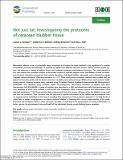Files in this item
Not just fat : investigating the proteome of cetacean blubber tissue
Item metadata
| dc.contributor.author | Kershaw, Joanna Louise | |
| dc.contributor.author | Botting, Catherine Helen | |
| dc.contributor.author | Brownlow, Andrew | |
| dc.contributor.author | Hall, Ailsa Jane | |
| dc.date.accessioned | 2018-02-28T12:30:05Z | |
| dc.date.available | 2018-02-28T12:30:05Z | |
| dc.date.issued | 2018 | |
| dc.identifier | 252133962 | |
| dc.identifier | 71ef3bec-1e45-41ba-b28b-e29dbecf0dc4 | |
| dc.identifier | 85052822155 | |
| dc.identifier | 000425547300001 | |
| dc.identifier.citation | Kershaw , J L , Botting , C H , Brownlow , A & Hall , A J 2018 , ' Not just fat : investigating the proteome of cetacean blubber tissue ' , Conservation Physiology , vol. 6 , no. 1 . https://doi.org/10.1093/conphys/coy003 | en |
| dc.identifier.issn | 2051-1434 | |
| dc.identifier.other | ORCID: /0000-0002-7562-1771/work/47136307 | |
| dc.identifier.uri | https://hdl.handle.net/10023/12818 | |
| dc.description.abstract | Mammalian adipose tissue is increasingly being recognized as an endocrine organ involved in the regulation of a number of metabolic processes and pathways. It responds to signals from different hormone systems and the central nervous system, and expresses a variety of protein factors with important paracrine and endocrine functions. This study presents a first step towards the systematic analysis of the protein content of cetacean adipose tissue, the blubber, in order to investigate the kinds of proteins present and their relative abundance. Full depth blubber subsamples were collected from dead-stranded harbour porpoises (Phocoena phocoena) (n = 21). Three total protein extraction methods were trialled, and the highest total protein yields with the lowest extraction variability were achieved using a RIPA cell lysis and extraction buffer based protocol. Extracted proteins were separated using 1D Sodium Dodecyl Sulphate Polyacrylamide Gel Electrophoresis (SDS-PAGE), and identified using nanoflow Liquid Chromatography Electrospray Ionization in tandem with Mass Spectrometry (nLC-ESI–MS/MS). A range of proteins were identified (n = 295) and classed into eight functional groups, the most abundant of which were involved in cell function and metabolism (45%), immune response and inflammation (15%) and lipid metabolism (11%). These proteins likely originate both from the various cell types within the blubber tissue itself, and from the circulation. They therefore have the potential to capture information on the cellular and physiological stresses experienced by individuals at the time of sampling. The importance of this proteomic approach is two-fold: Firstly, it could help to assign novel functions to marine mammal blubber in keeping with current understanding of the multi-functional role of adipose tissue in other mammals. Secondly, it could lead to the development of a suite of biomarkers to better monitor the physiological state and health of live individuals though remote blubber biopsy sampling. | |
| dc.format.extent | 15 | |
| dc.format.extent | 651607 | |
| dc.language.iso | eng | |
| dc.relation.ispartof | Conservation Physiology | en |
| dc.subject | Adipose tissue | en |
| dc.subject | Biomarkers | en |
| dc.subject | Marine mammals | en |
| dc.subject | Metabolism | en |
| dc.subject | Proteomics | en |
| dc.subject | QH301 Biology | en |
| dc.subject | NDAS | en |
| dc.subject | SDG 14 - Life Below Water | en |
| dc.subject.lcc | QH301 | en |
| dc.title | Not just fat : investigating the proteome of cetacean blubber tissue | en |
| dc.type | Journal article | en |
| dc.contributor.sponsor | NERC | en |
| dc.contributor.sponsor | NERC | en |
| dc.contributor.sponsor | The Wellcome Trust | en |
| dc.contributor.institution | University of St Andrews. School of Biology | en |
| dc.contributor.institution | University of St Andrews. Sea Mammal Research Unit | en |
| dc.contributor.institution | University of St Andrews. School of Chemistry | en |
| dc.contributor.institution | University of St Andrews. EaSTCHEM | en |
| dc.contributor.institution | University of St Andrews. Biomedical Sciences Research Complex | en |
| dc.contributor.institution | University of St Andrews. Marine Alliance for Science & Technology Scotland | en |
| dc.contributor.institution | University of St Andrews. Scottish Oceans Institute | en |
| dc.identifier.doi | https://doi.org/10.1093/conphys/coy003 | |
| dc.description.status | Peer reviewed | en |
| dc.identifier.grantnumber | NE/R015007/1 | en |
| dc.identifier.grantnumber | Agreement R8-H12-86 | en |
| dc.identifier.grantnumber | 094476/Z/10/Z | en |
This item appears in the following Collection(s)
Items in the St Andrews Research Repository are protected by copyright, with all rights reserved, unless otherwise indicated.

